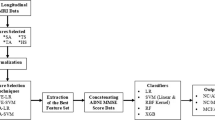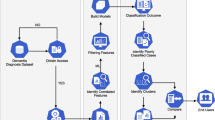Abstract
According to the Dementia India report 2010, it is estimated that over 3.7 million people are affected by dementia and is expected to be double by 2030. Around 60–80% of the demented are suffering from Alzheimer’s disease. Neuropsychological tests are useful tools for diagnosis of dementia. Diagnosis of dementia using machine learning for low- and middle-income setting is a rare study. Various attributes are used for diagnosing dementia. Finding the prominent attributes among them is a tedious job. Chi-squared, gain ratio, info gain and ReliefF filtering techniques are used for finding the prominent attributes. Cognitive score is identified as the most prominent attribute.
Access this chapter
Tax calculation will be finalised at checkout
Purchases are for personal use only
Similar content being viewed by others
References
Bhagyashree SR, Sheshadri HS (2014) An initial investigation in the diagnosis of Alzheimer’s disease using various classification techniques. IEEE international conference on computational intelligence and computing research (ICCIC), pp 1–5
Gaugler J, James B, Johnson T, Scholz K, Weuve J, (2015) Sc.D Alzheimer’s Association 2015 Alzheimer’s disease facts and figures. Alzheimer’s & Dementia 2015, pp 1–83
Prince M, Bryce R, Albanese E, Wimo A, Ribeiro W, Ferri CP (2013) The global prevalence of dementia: a systematic review and metaanalysis. Alzheimer’s dement 9(1):63–75.e2. https://doi.org/10.1016/j.jalz.012.11.007
Bhagya Shree SR, Sheshadri HS (2014) An approach to preprocess data in the diagnosis of Alzheimer’s disease. IEEE international conference on cloud computing and internet of things (CCIOT 2014), pp 135–139
Luisa AL et al (2009) Population normative data for the 10/66 Dementia Research Group cognitive test battery from Latin America, India and China: across sectional survey. Access NIH public, PubMed central, BMC Neurol 9:1–11
Bhagya Shree SR, Sheshadri HS (2016) Diagnosis of Alzheimer’s disease using Naive Bayesian Classifier. NCAA, Neural Comput Appl 29:1–10
Bhagya Shree SR, Sheshadri HS, Joshi S (2014) A review on the method of diagnosing Alzheimer’s disease using data mining. Int J Eng Res Technol 3(3):2417–2420. ISSN: 2278–0181
Shree SB, Sheshadri H (2014) An initial investigation in the diagnosis of Alzheimer’s disease using various classification techniques. In: 2014 IEEE international conference on computational intelligence and computing research (ICCIC). IEEE, pp 1–5
Shaji K, Jotheeswaran A, Girish N, Bharath S, Dias A, Pattabiraman M, Varghese M (2010) Alzheimer’s and related disorders society of India. The Dementia India Report: prevalence, impact, costs and services for Dementia
Esfandiari N, Babavalian MR, Moghadam A-ME, Tabar VK (2014) Knowledge discovery in medicine: current issue and future trend. Expert Syst Appl 41(9):4434–4463
Taneja A et al Heart disease prediction system using data mining techniques. Orient J Comput Sci Technol 6(4):457–466
Rajeswari P, Reena GS (2010) Analysis of liver disorder using data mining algorithm. Global J Comput Sci Technol 10(14):48
Henderson AS, Jorm AF (2000) Definition of epidemiology of dementia: a review. Dementia 2:1–33
Vanaja S, Kumar KR (2014) Analysis of feature selection algorithms on classification: a survey. Int J Comput Appl 96(17):975
Hussain L, Aziz W, Nadeem S, Abbasi A (2014) Classification of normal and pathological heart signal variability using machine learning techniques
Novaković J, Štrbac P, Bulatović D (2011) Toward optimal feature selection using ranking methods and classification algorithms. Yugoslav J Oper Res 21(1). ISSN: 0354-0243 EISSN: 2334-6043
Ladha L, Deepa T (2011) Feature selection methods and algorithms. Int J Comput Sci Eng 1(3):1787–1797
Yu J, Hu S, Wang J, Wong GKS, Li S, Liu B, Deng Y, Dai L, Zhou Y (2002) A draft sequence of the rice genome (Oryza sativa L. ssp. indica). American Association for the Advancement of Science
Wu X, Kumar JV, Quinlan R, Ghosh J, Yang Q, Motoda H, Geoffrey J, Ng MN, Liu B, Yu PS, Zhou Z-H, Steinbach M, Hand DJ, Steinberg D (2008) Top 10 algorithms in data mining. Springer, pp 1–37
Ferreira D et al (2012) Applying data mining techniques to improve diagnosis in neonatal jaundice. BMC Med Inform Decis Making 1–5
Acknowledgements
We are grateful to the participants and their family members for taking part in this study. Our sincere thanks to Principal and Management of ATME College of Engineering.
Author information
Authors and Affiliations
Corresponding author
Editor information
Editors and Affiliations
Ethics declarations
The ethics approval for this study was obtained from the Ethics Committee of CSI Holdsworth Memorial Hospital, Mysore.
Only those participants who were able to provide fully informed consent participated in this study and the informed consent was obtained from the participants.
Conflict of Interest
None of the authors have any conflict of interest to declare.
Rights and permissions
Copyright information
© 2019 Springer Nature Switzerland AG
About this paper
Cite this paper
Bhagyashree, S.R., Muralikrishna (2019). Investigating the Impact of Various Feature Selection Techniques on the Attributes Used in the Diagnosis of Alzheimer’s Disease. In: Pandian, D., Fernando, X., Baig, Z., Shi, F. (eds) Proceedings of the International Conference on ISMAC in Computational Vision and Bio-Engineering 2018 (ISMAC-CVB). ISMAC 2018. Lecture Notes in Computational Vision and Biomechanics, vol 30. Springer, Cham. https://doi.org/10.1007/978-3-030-00665-5_166
Download citation
DOI: https://doi.org/10.1007/978-3-030-00665-5_166
Published:
Publisher Name: Springer, Cham
Print ISBN: 978-3-030-00664-8
Online ISBN: 978-3-030-00665-5
eBook Packages: EngineeringEngineering (R0)




